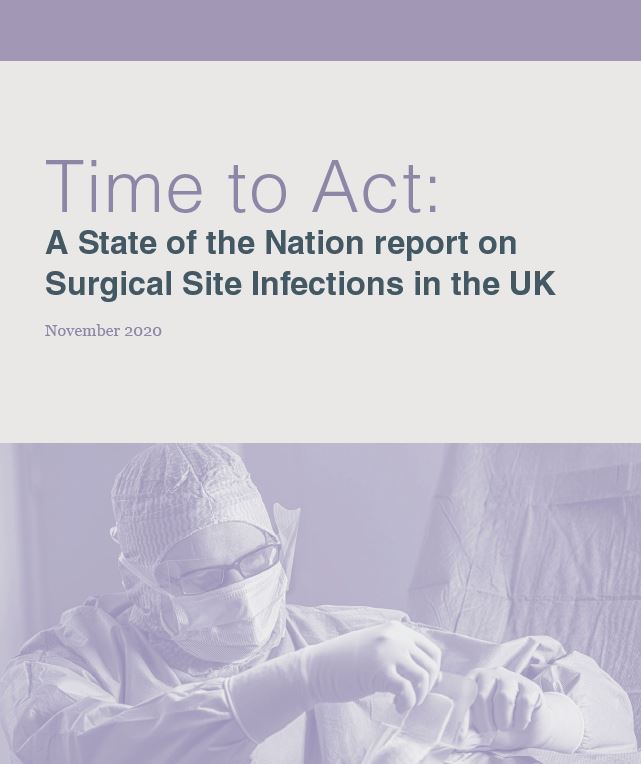Time to Reflect: why SSI prevention is part of the puzzle in addressing the elective care backlog

Prevention of surgical site infections will be critical if the NHS is to overcome the elective care backlog.
A year ago, Mölnlycke published a first-of-its-kind report: Time to Act: A State of the Nation report on Surgical Site Infections in the UK, which examined the impact of surgical site infections (SSIs) in the NHS. When this report was published, there were around 4.5 million people waiting for surgery. As the elective care backlog continues to grow, with the latest data showing around 6 million people waiting for elective care in England,1 the need to reflect on and implement the report’s findings is more urgent than ever.
Time to Act revealed how SSIs impact on patients and wider health services and set out recommendations for healthcare stakeholders to play their part in driving down the rate of SSIs. All partners within the health system, from policymakers to medical Royal Colleges and patient organisations have a role to play in helping to drive down infection rates and ensuring confidence that surgery is as safe as possible.
Reflecting on Time to Act
As Time to Act highlighted, SSIs pose considerable challenges for healthcare systems across the world, and have a substantial impact on healthcare professionals and patients alike. While research shows that up to 60 per cent of SSIs are preventable,2 3 these infections are known to have a devastating impact on patients, affecting not only their physical health, but also their mental health and employment. SSIs are also4 detrimental to the health service, with each infection estimated to cost between £10,0005 and £100,0006 per patient. As some SSIs can also require revision surgery, and lead to increased hospital stays7 this can place further strain on surgical waiting lists at a time when they are already increasing due to the backlog of care.
The latest available SSI surveillance report for NHS hospitals in England from December 2020 shows that great progress is being made – with nine out of the 13 voluntary reporting categories showing decreasing SSI risk from the previous year; while the mandatory orthopaedic categories showed decreasing trends over ten years.8 As the NHS looks to drastically increase the rate of surgical procedures to grapple with ominous backlogs in elective care, it is essential that this progress is cemented, and that these encouraging trends continue.
SSI prevention must be prioritised as the elective care backlog is tackled
Reducing the number of patients waiting for care will be the central priority of both government and the NHS in 2022 and beyond, and integral to this will be getting more patients into operating theatres. Scaling up the number of surgeries will require collaboration across the health system, as will minimising the risk to patients of contracting an SSI.
Patients and healthcare professionals alike must feel confident that they are protected in the operating theatre, and that appropriate measures have been put in place to reduce risks. The Time to Act report set out several recommendations for hospitals to help raise awareness of SSIs and reduce risk, including delivering training and education programmes on reducing preventable SSIs; and for surgical teams to take all evidence-based preventative steps possible during a patient’s journey through surgery to help reduce the incidence of SSIs.
As elective recovery looks to be the most significant aim of the health service in 2022, it is more important than ever these recommendations are taken forward.
How Mölnlycke has taken action
Over the past 12 months, Mölnlycke has been working alongside healthcare professionals and patient groups to support the delivery of the recommendations in the Time to Act report.
Mölnlycke has created an SSI prevention hub, with resources and materials for healthcare professionals to support them in reducing the risk of SSIs in their workplaces.9 They have also convened an advisory board with preeminent surgeons, surveillance leads and patient organisations, to work together on identifying and supporting the areas of greatest need when it comes to SSI prevention.
To date, this group has explored issues around the use of quality improvement to prevent SSIs and the importance of patient education and the patient voice. Mölnlycke will shortly be launching materials to support both healthcare professionals and patients on these topics, to empower them to play their part in reducing and preventing SSIs.
Ensuring SSI prevention remains a priority
With surgery set to be the key focus of health leaders and policymakers in 2022, reducing preventable infections in the operating theatre must remain a central priority. It is vital that prevention remains at the forefront, as the number of surgeries increases in the coming months. We at Mölnlycke are proud to continue to work as ‘Partners in Protection’ to drive forward progress and ensure that SSI prevention remains a key priority in tackling the elective care backlog.
Request the full Time to Act report to learn more about the impact of SSIs on the health system.

References
[1] British Medical Association analysis of NHS Digital figures (February 2022) https://www.bma.org.uk/advice-and-support/nhs-delivery-and-workforce/pressures/nhs-backlog-data-analysis
[2] V.Diaz, J.Newman. Surgical Site Infection and Prevention Guidelines: A primer for certified registered nurse anesthetists. 2015. Available from: https://www.aana.com/docs/defaultsource/aana-journal-web-documents-1/jcourse6-0215-pp63-68. pdf?sfvrsn=1ad448b1_6
[3] NICE guideline [NG125] Surgical site infections: prevention and treatment. April 2019. Available from: https://www.nice.org.uk/ guidance/ng125/chapter/Context
[4] Tanner J, Khan D, Aplin C, Ball J, Thomas M, Bankart J. Post discharge surveillance to identify colorectal surgical site infection rates and related costs. J Hosp Infect 2009;72:243-250
[5] Tanner J, Khan D, Aplin C, Ball J, Thomas M, Bankart J. Post discharge surveillance to identify colorectal surgical site infection rates and related costs. J Hosp Infect 2009;72:243e50
[6] Getting It Right First Time. GIRFT SSI National Survey. 2019
[7] Harrop JS, Styliaras JC, Ooi YC, Radcliff KE, Vaccaro AR, Wu C. Contributing factors to surgical site infections. J Am Acad Orthop Surg. 2012 Feb;20(2):94-101. doi: 10.5435/JAAOS-20-02-094. PMID: 22302447.
[7] Surveillance of surgical site infections in NHS hospitals in England April 2019 to March 2020, Public Health England, https://assets.publishing.service.gov.uk/government/uploads/system/uploads/attachment_data/file/945712/SSI_Annual_Report_2019_20.pdf
[9] https://www.molnlycke.co.uk/campaigns/surgical-site-infections/
This article was kindly sponsored by Mölnlycke
